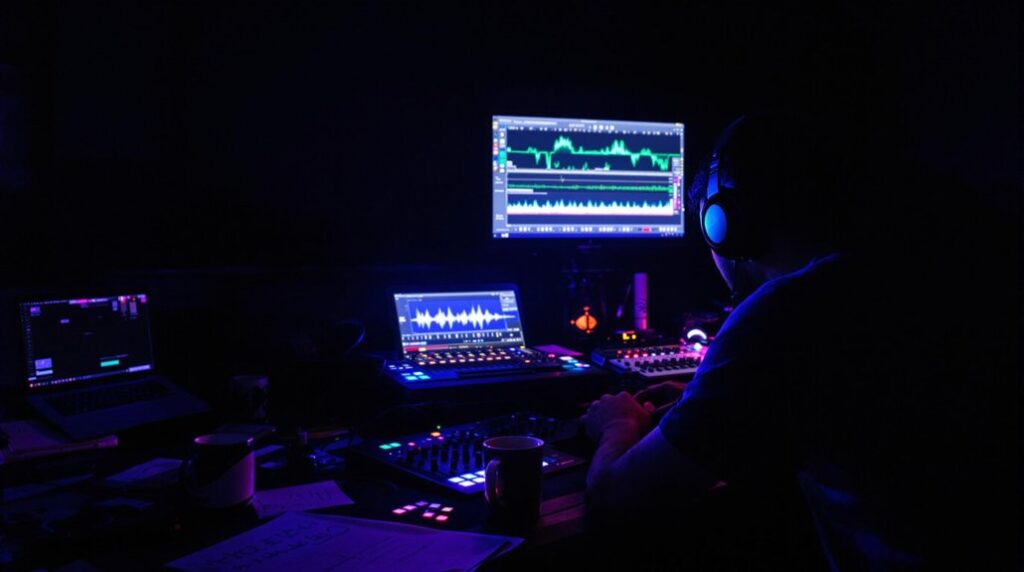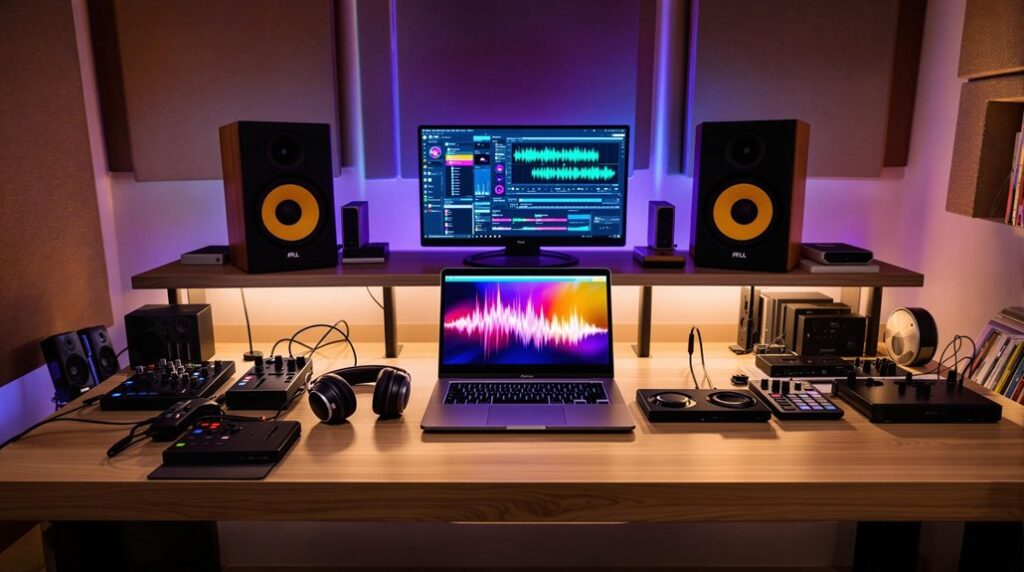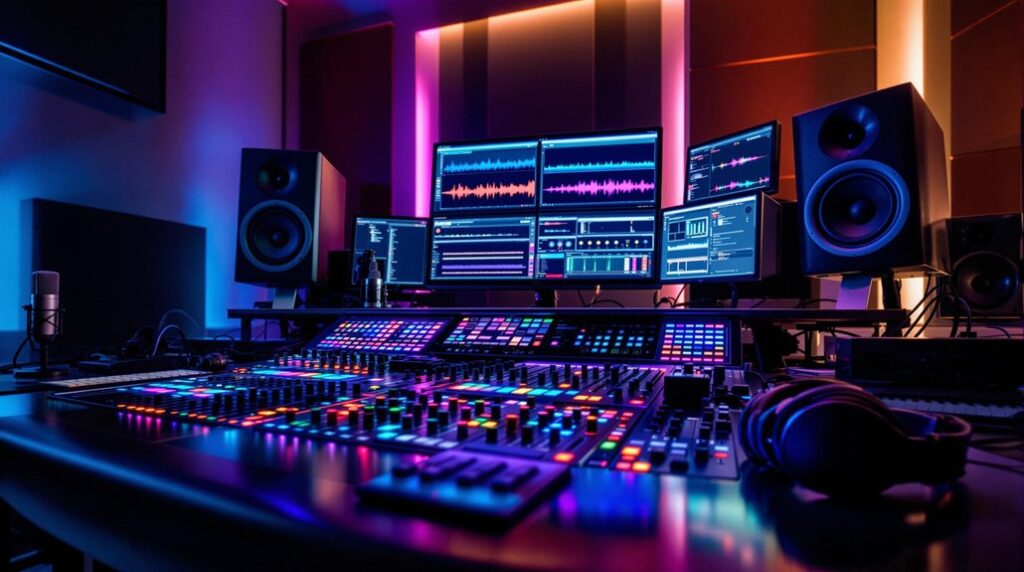To guarantee your mixes translate on any system, start by frequently switching between mono and stereo monitoring for phase and balance accuracy. Apply harmonic distortion to add richness and clarity, particularly to low-end elements. Focus on EQ to carve out space for each instrument and layer your kick drum with hi-hat samples to enhance clarity. Simulate different playback environments using tools like MixChecker, and rigorously test your mix on various devices. Maintain a consistent and moderate listening volume, ideally between 75-90 dB SPL, for balanced adjustments. By refining these techniques, you’ll achieve a mix that consistently sounds great everywhere.
Key Takeaways
- Test your mix on various playback devices, including headphones, car speakers, and consumer-grade monitors.
- Regularly switch between mono and stereo to ensure phase coherence and balance.
- Use speaker simulation tools like MixChecker to optimize your mix for different systems.
- Apply EQ adjustments based on reference tracks to achieve accurate tonal balance.
- Maintain moderate listening volume between 75-90 dB SPL for consistent mix integrity.
Monitor in Mono
Monitoring in mono helps you identify and resolve phase issues, stereo imaging problems, and mono compatibility concerns in your mix with precision. One of the primary advantages of mono monitoring is its capability to expose elements that might disappear or clash when played in stereo. This practice enhances mix clarity and balance, making sure that each element is audible and well-defined.
However, a notable drawback is that it may initially seem essential, especially if you’re accustomed to mixing in stereo.
Adopting best practices is vital for effective mono monitoring. Start by frequently switching between mono and stereo to catch inconsistencies and phase issues early. Guarantee that all mix elements remain clear and balanced in both modes. Avoid common mistakes such as relying solely on stereo effects to create space; instead, focus on carving out frequency ranges to prevent masking issues.
Another advantage of mono monitoring is that it leads to more cohesive and consistent sound across various playback systems. However, don’t overlook the importance of stereo imaging. While mono monitoring is important, balancing it with stereo checks ensures that your mix translates well universally.
Use Harmonic Distortion
When you use harmonic distortion, you can enhance the sonic character of your tracks by adding harmonics that fill in missing low-end detail.
This not only controls dynamic range but also adds subtle warmth, making your mix more cohesive.
Enhance Sonic Character
Utilizing harmonic distortion on low-end instruments like the kick and bass can greatly enhance the sonic character of your mix, guaranteeing it translates well across various playback systems. By adding harmonic saturation, you fill in the missing low-end detail that smaller systems often fail to reproduce, thereby improving tonal balance and overall clarity.
The application of harmonic distortion results in frequency enhancement, making the bass and kick cut through the mix more effectively. This technique is crucial for mix translation, ensuring your track sounds consistent whether played on a high-end studio monitor or a basic smartphone speaker.
Consider the following technical strategies:
- Use distortion plugins: Apply subtle distortion to TR808 kicks to create harmonics that add depth and presence.
- Layer higher frequency sounds: Combine kicks with elements like hi-hats to bring out upper harmonics.
- Tune hi-hat samples: Adjust hi-hat frequencies to align with the kick pattern for more cohesive integration.
- Subtle mixing: Blend higher frequency elements discreetly to enhance clarity without overwhelming the mix.
- Monitor on various systems: Regularly check your mix on different playback systems to guarantee consistent translation.
Control Dynamic Range
Incorporating harmonic distortion effectively controls dynamic range by filling in missing frequencies, ensuring your mix maintains clarity and detail across diverse playback systems.
By adding harmonics to instruments like kick and bass, you enhance their presence, making them more noticeable on smaller speakers. To achieve this, utilize parallel compression to retain the natural dynamics while introducing controlled distortion.
Parallel compression allows you to blend the unprocessed signal with a compressed version, ensuring both clarity and punch.
Experiment with saturation levels to find the sweet spot where your mix benefits from added harmonics without becoming overly distorted. Subtle saturation can introduce warmth and richness, filling in gaps in the frequency spectrum.
Layering kicks with higher frequency sounds and tuning down hi-hat samples can also add clarity and detail to your low-end, ensuring it translates well on different systems.
Apply EQ to the master chain to simulate playback on smaller systems, and mono the output for an accurate representation of how your mix will sound in less-than-ideal listening environments.
Add Warmth Subtly
To further enhance your mix’s presence and warmth, subtly applying harmonic distortion can introduce additional depth and richness. By adding gentle distortion, you can fill out sounds and add harmonic content that makes elements more engaging without overpowering the mix.
Here’s how you can effectively use this technique:
- Experiment with saturation: Use different saturation plugins to find the right texture and warmth for your tracks.
- Blend different distortion types: Combine various types of distortion, like tape, tube, or transistor-based, to achieve a unique, balanced sound.
- Target specific elements: Apply harmonic distortion to individual tracks, such as vocals or drums, to enhance their presence without affecting the entire mix.
- Parallel processing: Use a parallel processing chain to blend clean and distorted signals, allowing for precise control over the amount of warmth added.
- Monitor levels: Make sure that the added distortion doesn’t introduce unwanted clipping or noise, keeping your mix clean and professional.
Carefully applied, harmonic distortion can improve the overall warmth of your mix. By balancing clean and subtly distorted elements, you’ll create a rich, full-bodied sound that translates well on any system.
Make sure to use your ears and constantly compare the processed and unprocessed signals to maintain clarity and depth.
EQ for Clarity
To achieve clarity in your mix, cut unnecessary frequencies that clutter the sound spectrum.
Balance instrument levels by ensuring each element sits well within its frequency range.
This approach reduces muddiness and enhances the overall definition of your mix.
Cut Unnecessary Frequencies
Cutting unnecessary frequencies with EQ is essential for achieving clarity and preventing muddiness in your mix. By engaging in precise frequency sculpting, you enhance sound clarity, ensuring your mix translates well across various playback systems.
Here are some critical EQ techniques to implement:
- High-pass filters: Use these to remove low-end rumble below 20Hz, which often contains inaudible frequencies that muddy your mix.
- Low-pass filters: Apply these to cut high-end noise above 20kHz, eliminating unwanted hiss and harshness.
- Targeted cuts: Identify and eliminate specific resonant frequencies that clash with other instruments, creating a cleaner mix.
- Carve out space: Focus on removing frequencies that don’t contribute to the overall sound, ensuring each instrument has its own space.
- Prevent frequency buildup: Monitor areas where multiple instruments might overlap and cut frequencies to avoid excessive buildup, maintaining overall balance.
Implementing these EQ techniques helps in achieving a cleaner, more defined mix. By methodically cutting unnecessary frequencies, you enhance mix translation, ensuring your tracks sound great on any system.
Balance Instrument Levels
After sculpting frequencies for clarity, it’s time to balance instrument levels to guarantee that each element shines in the mix. Begin by using spectral analysis to identify peaks in your instrument levels. Adjust these peaks to avoid frequency masking, making sure each instrument occupies its own space.
Utilize volume automation to control dynamics, making subtle adjustments that enhance the overall balance without overwhelming the mix.
Next, employ EQ to carve out specific frequency ranges for each instrument. This will help enhance clarity and prevent any overlap that could muddy your mix. Focus on the mid-range frequencies, as they hold much of the energy and presence. Make sure that vocals and lead instruments are given prominence by allowing them to peak higher on the spectrum.
Panning techniques and stereo imaging play significant roles in this process. By strategically placing instruments within the stereo field, you can create a more spacious and balanced mix. Utilize sidechain compression to emphasize vocals and lead instruments without sacrificing the balance of other elements. This technique helps maintain clarity while allowing the mix to breathe.
Layer Your Kick
Layering your kick with higher frequency sounds like hi-hat samples enhances its clarity and presence in the mix. This kick enhancement technique guarantees that your kick drum stands out, even on smaller speaker systems.
By blending frequencies, you achieve a sonic impact that cuts through the mix.
To get started, consider these layering techniques:
- Tune Down Hi-Hat Samples: Lower the pitch of a hi-hat sample to match your kick pattern. This adds high-frequency content that helps the kick cut through.
- Add Harmonics and Distortion: Apply harmonic distortion to your kick. This can fill in low-end details, especially useful for systems that lack response above 120Hz.
- Supplement with Clicky Sounds: Layer sounds with more click and attack. This improves the snappiness and definition of your kick.
- Experiment with Different Layers: Try various sounds and processing techniques to find the best combination for your kick.
- Subtle Mixing: Make sure that your added layers don’t overpower the original kick. Blend them in subtly to maintain balance.
Simulate Different Setups
Frequently, achieving a well-balanced mix involves simulating playback on various systems to guarantee consistency and clarity across different listening environments. By using speaker simulations, such as the MixChecker plug-in, you can replicate how your mix will sound on headphones, car speakers, and laptops. This step helps identify frequency imbalances that may not be apparent on your primary studio monitors.
To further refine your mix, apply EQ adjustments to the master chain. Rolling off lows at 150Hz and highs at 5kHz can optimize your mix for smaller setups by preventing excessive bass and treble that won’t translate well on less capable systems. This safeguards your mix maintains its integrity no matter where it’s played.
Additionally, mono the master output to accurately represent how the mix will sound on mono systems. This helps you verify phase coherence and ensures that all elements of your mix are audible when summed to mono, a common scenario in many playback environments.
Before bouncing out the final version of your song, bypass any unnecessary plug-ins to secure the mix translates well across all systems. This meticulous process will lead to a mix that sounds great everywhere.
Test on Various Devices
Guarantee your mix sounds consistent by testing it on various playback devices such as headphones, car speakers, and consumer-grade monitors. This step validates your mix translates well across different listening environments.
- Headphones: Use both studio and consumer-grade headphones to identify any discrepancies in the mix.
- Car Speakers: Check your mix in a car to see how it performs outside of a controlled studio environment.
- Consumer-Grade Monitors: These mimic what average listeners might use, helping you catch issues you mightn’t hear on professional monitors.
- Reference Tracks: Choose well-mixed reference tracks to compare against your mix and make precise EQ adjustments.
- MixChecker Plug-in: Utilize this tool to simulate various playback systems without needing physical devices, streamlining the process.
Pay close attention to speaker positioning and room acoustics, as these factors significantly impact how your mix sounds. Adjust EQ settings based on what you hear across different systems.
Experiment with various playback volumes, but keep the SPL levels moderate to maintain your mix’s integrity. By following these steps, you’ll address frequency response issues and achieve a mix that sounds great no matter where it’s played.
Control Your Listening Volume
Maintaining a moderate listening volume, typically between 75-90 dB SPL, is essential for achieving a balanced mix that translates well across different playback systems. Consistent levels are important for preserving mix balance, and using an SPL meter guarantees you’re hitting the right decibels.
Volume calibration in your studio helps you maintain these consistent listening levels. This process involves setting a Rooms Volume Calibration Level (RCVL) tailored to your monitoring environment.
Calibrating your volume to the RCVL ensures that you’re always mixing at the best level, thereby maintaining a reliable reference point. This consistency aids you in making precise mix adjustments that will sound good across various playback systems, from high-end studio monitors to car speakers.
Additionally, controlling your listening volume is essential for ear protection. Prolonged exposure to high decibels can lead to hearing damage, which will negatively impact your ability to mix effectively over time.
Frequently Asked Questions
What Is Mix Translation?
Mix translation guarantees that your mix sounds consistent across various playback systems. You achieve this by using monitor calibration to adjust your setup and reference tracks to compare and fine-tune balance, clarity, and overall sound.
How to Make Your Mix Sound Professional?
To make your mix sound professional, use reference tracks to guide your balance and tonal choices. Maintain a controlled dynamic range to guarantee clarity. Implement spectral analysis and stereo imaging to create a polished, cohesive mix.
How to Properly Mix a Song?
To properly mix a song, start with accurate gain staging to avoid clipping. Use reference tracks to compare levels and EQ. Apply compression and effects carefully. Consistently evaluate your mix, balancing elements for a cohesive sound.
How to Start a Mix?
Start by setting up proper monitor placement to guarantee accurate sound. Then, choose reference tracks that match your desired sound. This helps you gauge tonal balance and stereo width, guiding your mix from the beginning.
Conclusion
By monitoring in mono, using harmonic distortion, EQing for clarity, layering your kick, simulating different setups, testing on various devices, and controlling your listening volume, you’ll guarantee your mixes translate well across any system.
These techniques help identify and address potential issues, providing a balanced and consistent sound.
Implementing these practices will enhance your mixing skills, resulting in professional-quality audio that sounds great no matter where it’s played.




